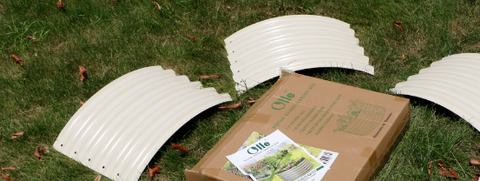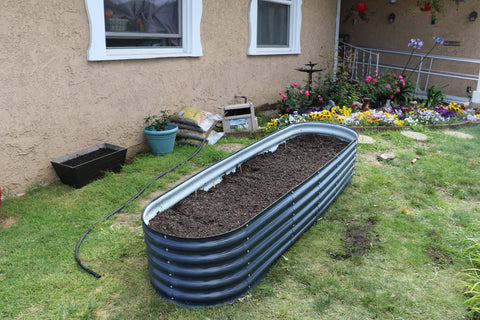How To Build a Raised Garden Bed?
A raised garden bed is one of the most effective ways to grow your own food. They allow you to better control soil conditions and provide a quick, easy harvest of crops. A raised garden bed can be as simple or as elaborate as you like, depending on your needs and what you want to achieve aesthetically. Use these guidelines to determine which type of raised bed will work best in your garden.
How to Build a raised garden bed?
Building a raised garden bed is a great DIY project for those who want to grow their own food. You just need some tools and some hardworking people. Check out a step-by-step slideshow from one of our columnists for creating a raised garden bed.

Choose the perfect location
Full sun is an absolute necessity for growing vegetables.
Flat ground will make installation a breeze.
Put away vegetable beds so they don't detract from the rest of the garden during the off-season.
Choosing materials for your raised garden bed
Untreated preservative wood is the most popular choice.
Avoid railroad ties, as they are treated with creosote, which can leak toxins into the soil.
Determine the size and layout of the bed
Don't make your bed wider than 4 feet so you can easily reach the center.
The ideal depth is between 12 and 24 inches.
Leave at least an 18" path between the beds, more if you want to use a wheelbarrow

Build a raised garden bed.
Wooden beds can be easily attached to the corners with galvanized screws (corner posts are optional), or use planter wall blocks in the corners and seams.
Stone or block beds can be installed with or without mortar.
Want instant gratification? Try galvanized stock pots or prefab loft beds, which come together in no time.
Arranged under the bed
Corrugated cardboard or newspaper will keep weeds or grasses from growing on raised beds.
Fill the Raised Bed with Soil

A good soil recipe for a raised bed is 1 part topsoil, 1 part compost manure, and 1 part sand.
Bagged soil can also be used.
Grow vegetables
Digging in the soft dirt will be easy and your back will thank you when you harvest.
If you have more than one bed, rotate each year.
How do you water a raised garden bed?
The best way to know when to water is to feel the soil. You want it to feel a little damp, like a wrung out towel. Vegetables don't like their soil too dry or too wet, so find the right balance. Watering in the morning will be more successful so the soil will dry out throughout the day.
Hand watering.
While this can be time-consuming, many gardeners prefer to water their raised beds by hand because they like to be in the garden and use this time to inspect their plants. In fact, you may even find the process therapeutic! Some people prefer to use a watering can because they don't have to worry about hose issues such as kinks and plant damage. However, the watering can can be heavy and you may need to return to the water source several times. A water spray wand attached to a hose is a great option to speed you up and easily get water to all the plants in your bed.
Automatic irrigation.
For those who don't have time to water a raised bed every day, a soaker hose or drip irrigation is a good option. A soaker hose, which slowly seeps water into the soil, can be laid throughout the bed to provide consistent moisture to all vegetables. Drip irrigation has small emitters that deliver water directly to the root zone of each plant at the perfect rate. Both options can be set to run on a timer, so you don't have to move your fingers.
How to Build a raised garden bed?
Building a raised garden bed is a great DIY project for those who want to grow their own food. You just need some tools and some hardworking people. Check out a step-by-step slideshow from one of our columnists for creating a raised garden bed.

Choose the perfect location
Full sun is an absolute necessity for growing vegetables.
Flat ground will make installation a breeze.
Put away vegetable beds so they don't detract from the rest of the garden during the off-season.
Choosing materials for your raised garden bed
Untreated preservative wood is the most popular choice.
Avoid railroad ties, as they are treated with creosote, which can leak toxins into the soil.
Determine the size and layout of the bed
Don't make your bed wider than 4 feet so you can easily reach the center.
The ideal depth is between 12 and 24 inches.
Leave at least an 18" path between the beds, more if you want to use a wheelbarrow

Build a raised garden bed.
Wooden beds can be easily attached to the corners with galvanized screws (corner posts are optional), or use planter wall blocks in the corners and seams.
Stone or block beds can be installed with or without mortar.
Want instant gratification? Try galvanized stock pots or prefab loft beds, which come together in no time.
Arranged under the bed
Corrugated cardboard or newspaper will keep weeds or grasses from growing on raised beds.
Fill the Raised Bed with Soil

A good soil recipe for a raised bed is 1 part topsoil, 1 part compost manure, and 1 part sand.
Bagged soil can also be used.
Grow vegetables
Digging in the soft dirt will be easy and your back will thank you when you harvest.
If you have more than one bed, rotate each year.
How do you water a raised garden bed?
The best way to know when to water is to feel the soil. You want it to feel a little damp, like a wrung out towel. Vegetables don't like their soil too dry or too wet, so find the right balance. Watering in the morning will be more successful so the soil will dry out throughout the day.
Hand watering.
While this can be time-consuming, many gardeners prefer to water their raised beds by hand because they like to be in the garden and use this time to inspect their plants. In fact, you may even find the process therapeutic! Some people prefer to use a watering can because they don't have to worry about hose issues such as kinks and plant damage. However, the watering can can be heavy and you may need to return to the water source several times. A water spray wand attached to a hose is a great option to speed you up and easily get water to all the plants in your bed.
Automatic irrigation.
For those who don't have time to water a raised bed every day, a soaker hose or drip irrigation is a good option. A soaker hose, which slowly seeps water into the soil, can be laid throughout the bed to provide consistent moisture to all vegetables. Drip irrigation has small emitters that deliver water directly to the root zone of each plant at the perfect rate. Both options can be set to run on a timer, so you don't have to move your fingers.
